First view from new Crew Dragon shows marble-like Earth
By Trevor Mogg
By Trevor Mogg
September 15, 2021
SpaceX has posted footage showing the stunning view now being enjoyed by its first all-civilian crew.
The historic Inspiration4 mission launched from Kennedy Space Center at just after 8 p.m. ET on Tuesday, September 15, with the four crewmates reaching Earth orbit a short while later.
The scenery from the Crew Dragon spacecraft is even more dramatic than what astronauts enjoy from the International Space Station (ISS), with the higher orbit giving Earth a more marble-like appearance. The Crew Dragon is orbiting Earth at an altitude of 358 miles (575 km), 100 miles (160 km) above the ISS and the furthest it’s ever traveled from our planet.
The video shared by SpaceX shows the spacecraft’s new glass dome. Its engineers were able to put it in place of the Crew Dragon’s docking mechanism as the Inspiration4 mission is not linking up with the space station. The dome is fitted beneath the nose cone, which is designed to open up when the spacecraft reaches orbit.
Crewmates Jared Isaacman, Hayley Arceneaux, Dr. Sian Proctor, and Chris Sembroski will orbit Earth for about three days before returning home.
During their time in space, they’ll conduct various science experiments in microgravity conditions — so long as they can turn their attention from the breathtaking view, that is.
Entrepreneur Isaacman, who founded payment processing company Shift4 Payments, secured the groundbreaking mission in a private deal with SpaceX. The three other three passengers were then selected through various means, with all four undergoing intense training for the flight over the last six months.
Isaacman made clear early on that the main goal of the Inspiration4 mission is to raise funds of at least $200 million for St. Jude Children’s Research Hospital in Memphis, Tennessee.
For SpaceX, the mission marks the start of a potentially lucrative space tourism business that will operate alongside its astronaut flights between Earth and the ISS, and small-satellite launches for private companies and its Starlink internet service.
SpaceX has posted footage showing the stunning view now being enjoyed by its first all-civilian crew.
The historic Inspiration4 mission launched from Kennedy Space Center at just after 8 p.m. ET on Tuesday, September 15, with the four crewmates reaching Earth orbit a short while later.
The scenery from the Crew Dragon spacecraft is even more dramatic than what astronauts enjoy from the International Space Station (ISS), with the higher orbit giving Earth a more marble-like appearance. The Crew Dragon is orbiting Earth at an altitude of 358 miles (575 km), 100 miles (160 km) above the ISS and the furthest it’s ever traveled from our planet.
The video shared by SpaceX shows the spacecraft’s new glass dome. Its engineers were able to put it in place of the Crew Dragon’s docking mechanism as the Inspiration4 mission is not linking up with the space station. The dome is fitted beneath the nose cone, which is designed to open up when the spacecraft reaches orbit.
Crewmates Jared Isaacman, Hayley Arceneaux, Dr. Sian Proctor, and Chris Sembroski will orbit Earth for about three days before returning home.
During their time in space, they’ll conduct various science experiments in microgravity conditions — so long as they can turn their attention from the breathtaking view, that is.
Entrepreneur Isaacman, who founded payment processing company Shift4 Payments, secured the groundbreaking mission in a private deal with SpaceX. The three other three passengers were then selected through various means, with all four undergoing intense training for the flight over the last six months.
Isaacman made clear early on that the main goal of the Inspiration4 mission is to raise funds of at least $200 million for St. Jude Children’s Research Hospital in Memphis, Tennessee.
For SpaceX, the mission marks the start of a potentially lucrative space tourism business that will operate alongside its astronaut flights between Earth and the ISS, and small-satellite launches for private companies and its Starlink internet service.
SpaceX blasts off for world's first tourist trip into orbit
Four civilians have blasted off into space on the first ever trip into orbit by amateur space travelers.

The rocket lifted off safely from Cape Canaveral in Florida on Wednesday night (local time)
A group of civilian space travelers has made history by becoming the first set of non-professional travelers to orbit the Earth.
Although amateurs have gone into space before, trained astronauts or cosmonauts have always been on board.
The SpaceX Dragon carrying four amateurs separated from the second stage of a Falcon 9 rocket 12 minutes after liftoff, according to a live video feed.
As of 00:50 UTC, the capsule was "officially in space," according to SpaceX.
"Dragon will conduct two phasing burns to reach its cruising orbit of 575 km (357 miles) where the crew will spend the next three days orbiting planet Earth," the company wrote on Twitter.
Who is on board for the trip?
Among the passengers is Jared Isaacman, the billionaire founder of payment processing company Shift4 Payments.
The 38-year-old high school dropout is funding the entire trip — named Inspiration4.
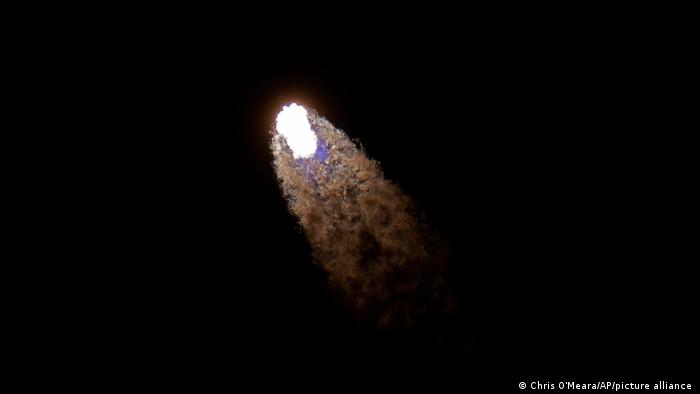
The Falcon rocket soared from the same Kennedy Space Center pad used by SpaceX's three previous astronaut flights for NASA
"A few have gone before and many are about to follow," said Isaacman.
He will be joined by Hayley Arceneaux, a nurse who beat bone cancer as a child. Arceneaux was treated at the St. Jude Children's Research Hospital, where she now works.
She was chosen for the trip after Isaacman donated a ticket to the hospital for a guest.
Arceneaux is the youngest American to go into space, and the first with a prosthesis — on part of her femur.
The two other seats were sold in a fundraising raffle for St. Jude.
They went to Chris Sembroski, an Air Force veteran and aerospace data engineer; and the geoscientist Sian Proctor.
Proctor is a geology professor who was almost selected to be an astronaut for NASA in 2009. She is set to become only the fourth African American woman to go to space.
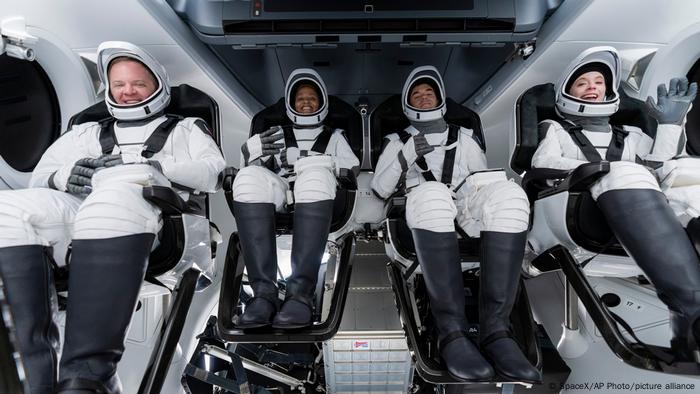
From left, Chris Sembroski, Sian Proctor, Jared Isaacman and Hayley Arceneaux sit in the Dragon capsule
What's the plan?
A Dragon capsule housing the passengers blasted off on top of a Falcon 9 rocket.
The departure was from the launch complex 39A at NASA's Kennedy Space Center in Florida. The complex is where the Apollo 11 mission took off for the Moon.
The spaceship's trajectory will take it to an altitude of 575 kilometers (357 miles), which is further into space than the International Space Station.
The four passengers will splash down off the coast of Florida at the end of their journey, with their descent slowed down by huge parachutes.
Mission to open up space
As well as raising money for the hospital, the mission has the stated goal of becoming a turning point in the democratization of space.
It aims to show that space travel is accessible to people who have not been handpicked and undergone years of training as astronauts.
It also marked the debut flight of SpaceX owner Elon Musk's new orbital tourism business, wherein wealthy customers are willing to pay a small fortune for the thrill — and bragging rights — of spaceflight.
Isaacman has reportedly paid an undisclosed sum to Musk for the mission to include himself and his three crewmates.
SpaceX regards the mission as a step towards humanity existing on multiple planets.
The biological data, including their heart rate and sleep statistics, will be analyzed as well as their cognitive abilities.
The team will also undergo tests before and after the trip, to see how it affects their bodies.
While the team's training only lasted about six months, they were put through their paces physically.
They had to trek to the summit of 14,411 feet (roughly 3,000 meters) Mount Rainier and complete G force training — both in a centrifuge and onboard a jet.
While the flight should be fully automated, the crew has been trained to take control in the event of an emergency.
Both Virgin Galactic's Richard Branson and Blue Origin's Jeff Bezos also blasted off from the Earth earlier this year as amateurs. However, their flights in July only briefly skimmed space rather than going into orbit, with Branson reaching 86 kilometers and Bezos 106 kilometers.
rc, as/msh (AFP, AP, Reuters)
First all-civilian crew launched to orbit aboard SpaceX rocket ship
Issued on: 16/09/2021 -
Video by:Fraser JACKSON
A billionaire e-commerce executive and three less-wealthy private citizens chosen to join him blasted off from Florida on Wednesday aboard a SpaceX rocket ship and soared into orbit, the first all-civilian crew ever to circle the Earth from space. The quartet of amateur astronauts, led by the American founder and chief executive of financial services firm Shift4 Payments Inc, Jared Isaacman, lifted off just before sunset from the Kennedy Space Center in Cape Canaveral.
Four civilians have blasted off into space on the first ever trip into orbit by amateur space travelers.

The rocket lifted off safely from Cape Canaveral in Florida on Wednesday night (local time)
A group of civilian space travelers has made history by becoming the first set of non-professional travelers to orbit the Earth.
Although amateurs have gone into space before, trained astronauts or cosmonauts have always been on board.
The SpaceX Dragon carrying four amateurs separated from the second stage of a Falcon 9 rocket 12 minutes after liftoff, according to a live video feed.
As of 00:50 UTC, the capsule was "officially in space," according to SpaceX.
"Dragon will conduct two phasing burns to reach its cruising orbit of 575 km (357 miles) where the crew will spend the next three days orbiting planet Earth," the company wrote on Twitter.
Who is on board for the trip?
Among the passengers is Jared Isaacman, the billionaire founder of payment processing company Shift4 Payments.
The 38-year-old high school dropout is funding the entire trip — named Inspiration4.

The Falcon rocket soared from the same Kennedy Space Center pad used by SpaceX's three previous astronaut flights for NASA
"A few have gone before and many are about to follow," said Isaacman.
He will be joined by Hayley Arceneaux, a nurse who beat bone cancer as a child. Arceneaux was treated at the St. Jude Children's Research Hospital, where she now works.
She was chosen for the trip after Isaacman donated a ticket to the hospital for a guest.
Arceneaux is the youngest American to go into space, and the first with a prosthesis — on part of her femur.
The two other seats were sold in a fundraising raffle for St. Jude.
They went to Chris Sembroski, an Air Force veteran and aerospace data engineer; and the geoscientist Sian Proctor.
Proctor is a geology professor who was almost selected to be an astronaut for NASA in 2009. She is set to become only the fourth African American woman to go to space.

From left, Chris Sembroski, Sian Proctor, Jared Isaacman and Hayley Arceneaux sit in the Dragon capsule
What's the plan?
A Dragon capsule housing the passengers blasted off on top of a Falcon 9 rocket.
The departure was from the launch complex 39A at NASA's Kennedy Space Center in Florida. The complex is where the Apollo 11 mission took off for the Moon.
The spaceship's trajectory will take it to an altitude of 575 kilometers (357 miles), which is further into space than the International Space Station.
The four passengers will splash down off the coast of Florida at the end of their journey, with their descent slowed down by huge parachutes.
Mission to open up space
As well as raising money for the hospital, the mission has the stated goal of becoming a turning point in the democratization of space.
It aims to show that space travel is accessible to people who have not been handpicked and undergone years of training as astronauts.
It also marked the debut flight of SpaceX owner Elon Musk's new orbital tourism business, wherein wealthy customers are willing to pay a small fortune for the thrill — and bragging rights — of spaceflight.
Isaacman has reportedly paid an undisclosed sum to Musk for the mission to include himself and his three crewmates.
SpaceX regards the mission as a step towards humanity existing on multiple planets.
The biological data, including their heart rate and sleep statistics, will be analyzed as well as their cognitive abilities.
The team will also undergo tests before and after the trip, to see how it affects their bodies.
While the team's training only lasted about six months, they were put through their paces physically.
They had to trek to the summit of 14,411 feet (roughly 3,000 meters) Mount Rainier and complete G force training — both in a centrifuge and onboard a jet.
While the flight should be fully automated, the crew has been trained to take control in the event of an emergency.
Both Virgin Galactic's Richard Branson and Blue Origin's Jeff Bezos also blasted off from the Earth earlier this year as amateurs. However, their flights in July only briefly skimmed space rather than going into orbit, with Branson reaching 86 kilometers and Bezos 106 kilometers.
rc, as/msh (AFP, AP, Reuters)
Issued on: 16/09/2021 -
Video by:Fraser JACKSON
A billionaire e-commerce executive and three less-wealthy private citizens chosen to join him blasted off from Florida on Wednesday aboard a SpaceX rocket ship and soared into orbit, the first all-civilian crew ever to circle the Earth from space. The quartet of amateur astronauts, led by the American founder and chief executive of financial services firm Shift4 Payments Inc, Jared Isaacman, lifted off just before sunset from the Kennedy Space Center in Cape Canaveral.
NASA video shows the cramped quarters where SpaceX's 4 civilian passengers will live for 3 days
The mission, called Inspiration4, will have four civilians orbiting in the spaceship for three days.
NASA astronauts' video from inside the ship shows how cramped their quarters will be.
Insider Healthcare: The latest healthcare news & analysis
SpaceX just launched four people, none of whom are professional astronauts, into Earth's orbit.
Now that crew is set to circle the planet for three days aboard the company's Crew Dragon spaceship. The inside of the capsule will probably get cramped. With four seats, control displays, and storage, the four passengers will have about enough space to move around as they would inside a walk-in closet.
Billionaire Jared Isaacman chartered the flight from SpaceX and called the mission Inspiration4. He gave the other three seats to Hayley Arceneaux, who survived bone cancer as a child and now works at St. Jude Children's Research Hospital; Chris Sembroski, an Air Force veteran who works for Lockheed Martin; and Dr. Sian Proctor, a geoscientist who serves as an analogue astronaut in simulations of long-term Mars missions.
In training for their mission, the Inspiration4 crew spent 30 hours inside the capsule together for a simulation at SpaceX headquarters in Hawthorne, California. During that time, they were cramped in a very small space. Gravity holding them down only made it smaller.
"We're literally sleeping right next to each other," Proctor told Axios reporter Miriam Kramer. "You're doing so many mental tasks and physical exertion that, even though it was not comfortable, I still fell asleep."
Now that they're in orbit, and they're all floating in microgravity, they can take advantage of the vertical space inside the capsule too. But even then, it will be cramped. Just watch these four astronauts giving a tour of Crew Dragon, high above Earth, in November:
Those astronauts were only inside the spaceship for about one day. Their Crew Dragon docked with the International Space Station, where the astronauts lived and worked for six months before climbing back aboard the spaceship and returning to Earth.
But unlike those astronauts, the Inspiration4 crew will have a glass dome at the nose of their spaceship. Because they don't need to dock to the space station, SpaceX replaced that docking port with this cupola. The passengers can stick their heads into the dome and get the full experience of drifting through space.

The Inspiration4 crew sits inside a model Crew Dragon spaceship. Left to right: Chris Sembroski, Sian Proctor, Jared Isaacman, and Hayley Arceneaux. SpaceX
SpaceX just launched its first tourist crew into Earth's orbit aboard its Crew Dragon spaceship.
SpaceX just launched its first tourist crew into Earth's orbit aboard its Crew Dragon spaceship.
The mission, called Inspiration4, will have four civilians orbiting in the spaceship for three days.
NASA astronauts' video from inside the ship shows how cramped their quarters will be.
Insider Healthcare: The latest healthcare news & analysis
SpaceX just launched four people, none of whom are professional astronauts, into Earth's orbit.
Now that crew is set to circle the planet for three days aboard the company's Crew Dragon spaceship. The inside of the capsule will probably get cramped. With four seats, control displays, and storage, the four passengers will have about enough space to move around as they would inside a walk-in closet.
Billionaire Jared Isaacman chartered the flight from SpaceX and called the mission Inspiration4. He gave the other three seats to Hayley Arceneaux, who survived bone cancer as a child and now works at St. Jude Children's Research Hospital; Chris Sembroski, an Air Force veteran who works for Lockheed Martin; and Dr. Sian Proctor, a geoscientist who serves as an analogue astronaut in simulations of long-term Mars missions.
In training for their mission, the Inspiration4 crew spent 30 hours inside the capsule together for a simulation at SpaceX headquarters in Hawthorne, California. During that time, they were cramped in a very small space. Gravity holding them down only made it smaller.
"We're literally sleeping right next to each other," Proctor told Axios reporter Miriam Kramer. "You're doing so many mental tasks and physical exertion that, even though it was not comfortable, I still fell asleep."
Now that they're in orbit, and they're all floating in microgravity, they can take advantage of the vertical space inside the capsule too. But even then, it will be cramped. Just watch these four astronauts giving a tour of Crew Dragon, high above Earth, in November:
Those astronauts were only inside the spaceship for about one day. Their Crew Dragon docked with the International Space Station, where the astronauts lived and worked for six months before climbing back aboard the spaceship and returning to Earth.
But unlike those astronauts, the Inspiration4 crew will have a glass dome at the nose of their spaceship. Because they don't need to dock to the space station, SpaceX replaced that docking port with this cupola. The passengers can stick their heads into the dome and get the full experience of drifting through space.
An illustration of SpaceX's Crew Dragon spaceship with a glass dome "cupola" at its nose. SpaceX
Incidentally, that's also where the spaceship's toilet is.
"When people do inevitably have to use the bathroom, they're going to have one hell of a view," Isaacman told Insider in June.
This Crew Dragon will feel roomy compared to what SpaceX has in store. In the future, the company plans to launch as many as seven people aboard the spaceship.
Incidentally, that's also where the spaceship's toilet is.
"When people do inevitably have to use the bathroom, they're going to have one hell of a view," Isaacman told Insider in June.
This Crew Dragon will feel roomy compared to what SpaceX has in store. In the future, the company plans to launch as many as seven people aboard the spaceship.
Inspiration4 mission will orbit Earth for around three days.
By Aimee Chanthadavong | September 16, 2021
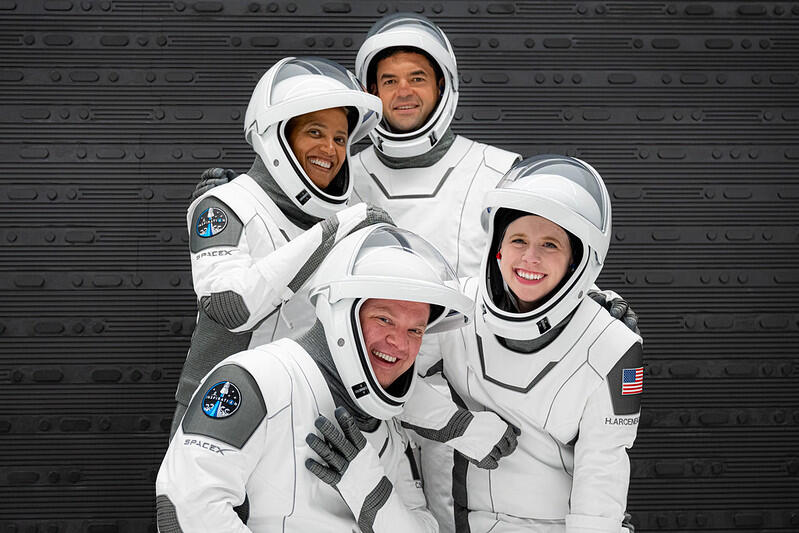
Image: SpaceX
SpaceX has launched what it is deeming as the "world's first all-civilian" crew into orbit as part of its Inspiration4 mission.
The Falcon 9 rocket lifted off from a launchpad at NASA's Kennedy Space Center at 8.02pm ET, 15 September 2021, and will now orbit Earth for roughly three days at an altitude of 575 kilometres -- just above the Hubble Space Telescope and 155 kilometres further from the International Space Station.
On board the company's fully automated Crew Dragon spacecraft are four crew members: Shift4 Payments founder and CEO Jared Issacman, cancer survivor Hayley Arceneaux, geoscientist Sian Proctor, and aerospace employee Chris Sembroski. They each underwent six months of training prior to launch.
During their time in space, the crew will perform "carefully selected research experiments on human health and performance" that will be used for potential applications for human health on Earth and during future spaceflights, SpaceX said.
"We are proud that our flight will help influence all those who will travel after us and look forward to seeing how this mission will help shape the beginning of a new era for space exploration," Issacman said.
Noticeably absent from the flight is SpaceX founder and tech billionaire Elon Musk. This is unlike Amazon founder Jeff Bezos who jumped on board Blue Origin's first crewed space launch and Richard Branson when he boarded Virgin Galactic's VSS Unity in July.
Between the three tech billionaires, it has been a head-to-head race to see whose aerospace company would be the first to make space travel available to paying civilians, not just for professional astronauts.
SpaceX launches four people to orbit in company's first-ever tourism mission
By Jackie Wattles, CNN Business
Updated September 16, 2021
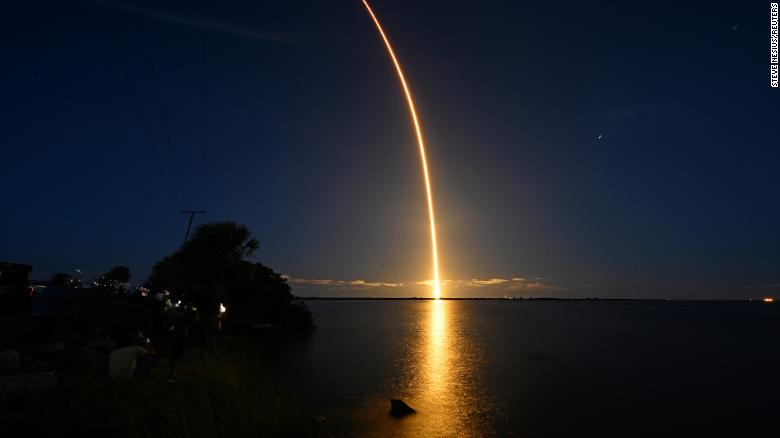
Cape Canaveral, Florida (CNN Business)A SpaceX rocket soared into orbit Wednesday evening, carrying four people — none of whom are professional astronauts — and kicking off the first-ever mission to Earth's orbit crewed entirely by tourists.
The launch pad at NASA's Kennedy Space Center in Florida was dramatically illuminated with spotlights against the night sky, and when the SpaceX rocket's nine engines fired up just after 8 pm ET it flooded the surrounding wetlands with a blaze of light as it soared into the upper atmosphere and made a dramatic, ghostly light show overhead. After reaching orbital speeds — more than 17,000 miles per hour — the capsule carrying the four passengers detached from the rocket and began to maneuver toward its intended orbit.
The team of amateurs — which include a billionaire who self-funded the mission, a cancer survivor, a community college teacher and a Lockheed Martin employee — strapped into their 13-foot-wide SpaceX Crew Dragon capsule Wednesday afternoon before their SpaceX rocket roared to life and blasted the capsule into orbit. The crew will remain aboard their capsule for three days as it flies through orbit before returning for a splashdown landing off the coast of Florida on Saturday.
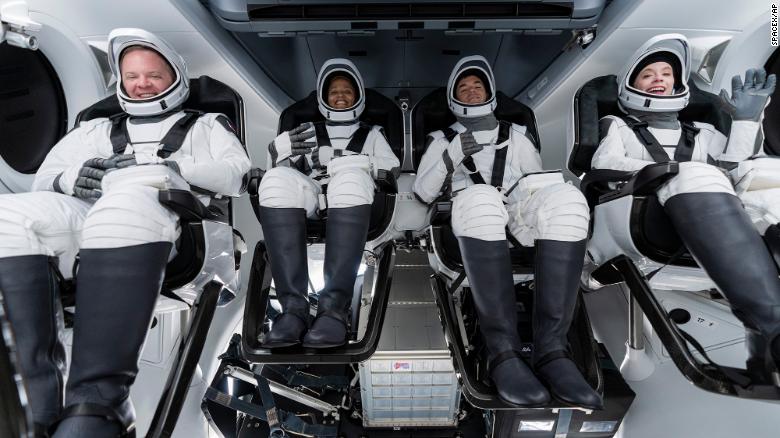
From left, Chris Sembroski, Sian Proctor, Jared Isaacman and Hayley Arceneaux sit in the Dragon capsule at Cape Canaveral in Florida on Sept. 12, 2021 during a dress rehearsal for the upcoming launch.
For the next three days, the passengers will float around the capsule as it circles around the planet once every 90 minutes, traveling at more than 17,500 miles per hour, while the passengers float and take in panoramic views of Earth. To cap off the journey, their spacecraft will dive back into the atmosphere for a fiery re-entry and splash down off the coast of Florida.
Splashdown is currently slated for Saturday, but that could change if weather or other issues prompt an earlier or later return. The capsule is stocked with enough food and supplies for about a week.
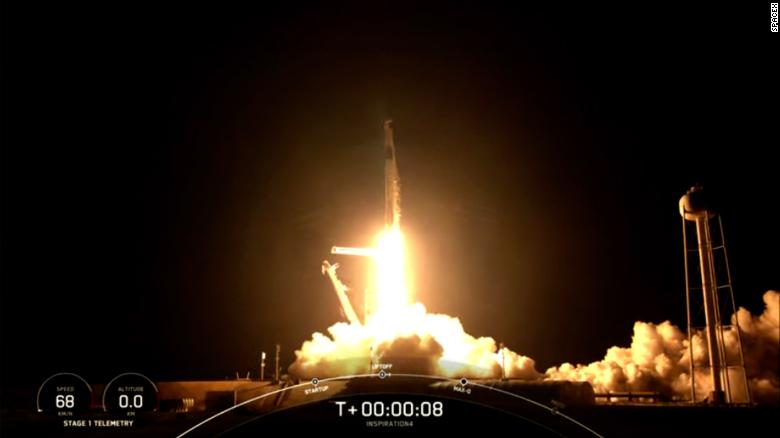
A SpaceX rocket carries the first-ever all-tourist crew into orbit.
This is only the third crewed launch from US soil in the past decade.
The crew includes 38-year-old billionaire Jared Isaacman, who personally financed the trip; Hayley Arceneux, 29, a childhood cancer survivor and current St. Jude physician assistant; Sian Procotor, 51, a geologist and community college teacher with a PhD; and Chris Sembroski, a 42-year-old Lockheed Martin employee and lifelong space fan who claimed his seat through an online raffle.
All four passengers will spend the entire mission aboard the SpaceX capsule, a 13-foot-wide, gumdrop-shaped spacecraft that detaches from SpaceX's Falcon 9 rocket after reaching orbital speeds and was originally built to carry NASA astronauts.
And yes, for all three days in space, the passengers will all have to share a special zero-gravity-friendly toilet located near the top of the capsule. No showering will be available, and crew will all have to sleep in the same reclining seats they will ride in during launch.
SpaceX hopes this will be the first of many similar tourism missions, paving the way toward a future when it's as common to take a jaunt to space as it is to hop on an airplane. And the Crew Dragon capsule is SpaceX's first step on the way there. Though it was designed and built under a NASA contract and intended to get astronauts to and from the International Space Station, SpaceX still owns and operates the vehicle and is allowed to sell seats or entire missions to whoever the companies wishes. And with that, SpaceX and its space tourism customers get to design the entire mission — from picking the flight path and training regiment all the way down to choosing whcih foods the passengers will munch on while in oribt.
At a press briefing Tuesday evening, Sembroski, the 42-year-old who got his ticket via a raffle, told reporters that joining the Inspriation4 mission felt like "we're writing the rules, we're breaking a couple of them that NASA used to demand...We get to kind of do things our own way."
This is far from the first time civilians have traveled to space. Though NASA has been averse to signing up non-astronauts for routine missions after the death of Christa McAuliffe, a New Hampshire school teacher who was killed in the Challenger disaster in 1986, a cohort of wealthy thrill-seekers paid their own way to the International Space Station in the 2000s through a company called Space Adventures. American investment management billionaire Dennis Tito became the first to self-fund a trip in 2001 with his eight-day stay on the International Space Station, and six others came after him. They all booked rides alongside professional astronauts on Russia's Soyuz spacecraft.

The Inspiration4 crew in an altitude chamber training on July 2, 2021, at Duke Health in Durham, North Carolina.
This mission, however, has been billed as the beginning of a new era of space travel in which average people, rather than government-selected astronauts and the occasional deep-pocketed adventurer, carry the mantle of space exploration.
But to be clear, we are still a long way from that reality, and this trip is still far from "average." It's a custom, one-off mission financed by a billionaire founder of a payment processing company, and though pricing details have not been made public, it likely cost upward of $200 million. (According to one government report, SpaceX's Crew Dragon capsule costs roughly $55 million per seat.)

Jared Isaacman during rollout at Launch Complex 39A on September 11, 2021.
Isaacman — who will become the third billionaire to self-fund a trip space in the past three months and the first to buy a trip to orbit on a SpaceX capsule — is billing this mission as one that he hopes will inspire would-be space adventureres, hence the missions's name, Inspiration4. He's also using it as the centerpiece for a $200 million fundraiser for St. Jude Children's Hospital, $100 million of which he donated personally and the rest he is hoping to raise through online donations and an auction set to begin Thursday. Items will include a ukulele that Sembroski will play in space and 66 pounds of beer hops.
So far, the fundraiser has brought in $31 million of its $100 million goal.
By Jackie Wattles, CNN Business
Updated September 16, 2021

Cape Canaveral, Florida (CNN Business)A SpaceX rocket soared into orbit Wednesday evening, carrying four people — none of whom are professional astronauts — and kicking off the first-ever mission to Earth's orbit crewed entirely by tourists.
The launch pad at NASA's Kennedy Space Center in Florida was dramatically illuminated with spotlights against the night sky, and when the SpaceX rocket's nine engines fired up just after 8 pm ET it flooded the surrounding wetlands with a blaze of light as it soared into the upper atmosphere and made a dramatic, ghostly light show overhead. After reaching orbital speeds — more than 17,000 miles per hour — the capsule carrying the four passengers detached from the rocket and began to maneuver toward its intended orbit.
The team of amateurs — which include a billionaire who self-funded the mission, a cancer survivor, a community college teacher and a Lockheed Martin employee — strapped into their 13-foot-wide SpaceX Crew Dragon capsule Wednesday afternoon before their SpaceX rocket roared to life and blasted the capsule into orbit. The crew will remain aboard their capsule for three days as it flies through orbit before returning for a splashdown landing off the coast of Florida on Saturday.

From left, Chris Sembroski, Sian Proctor, Jared Isaacman and Hayley Arceneaux sit in the Dragon capsule at Cape Canaveral in Florida on Sept. 12, 2021 during a dress rehearsal for the upcoming launch.
For the next three days, the passengers will float around the capsule as it circles around the planet once every 90 minutes, traveling at more than 17,500 miles per hour, while the passengers float and take in panoramic views of Earth. To cap off the journey, their spacecraft will dive back into the atmosphere for a fiery re-entry and splash down off the coast of Florida.
Splashdown is currently slated for Saturday, but that could change if weather or other issues prompt an earlier or later return. The capsule is stocked with enough food and supplies for about a week.

A SpaceX rocket carries the first-ever all-tourist crew into orbit.
This is only the third crewed launch from US soil in the past decade.
The crew includes 38-year-old billionaire Jared Isaacman, who personally financed the trip; Hayley Arceneux, 29, a childhood cancer survivor and current St. Jude physician assistant; Sian Procotor, 51, a geologist and community college teacher with a PhD; and Chris Sembroski, a 42-year-old Lockheed Martin employee and lifelong space fan who claimed his seat through an online raffle.
All four passengers will spend the entire mission aboard the SpaceX capsule, a 13-foot-wide, gumdrop-shaped spacecraft that detaches from SpaceX's Falcon 9 rocket after reaching orbital speeds and was originally built to carry NASA astronauts.
And yes, for all three days in space, the passengers will all have to share a special zero-gravity-friendly toilet located near the top of the capsule. No showering will be available, and crew will all have to sleep in the same reclining seats they will ride in during launch.
SpaceX hopes this will be the first of many similar tourism missions, paving the way toward a future when it's as common to take a jaunt to space as it is to hop on an airplane. And the Crew Dragon capsule is SpaceX's first step on the way there. Though it was designed and built under a NASA contract and intended to get astronauts to and from the International Space Station, SpaceX still owns and operates the vehicle and is allowed to sell seats or entire missions to whoever the companies wishes. And with that, SpaceX and its space tourism customers get to design the entire mission — from picking the flight path and training regiment all the way down to choosing whcih foods the passengers will munch on while in oribt.
At a press briefing Tuesday evening, Sembroski, the 42-year-old who got his ticket via a raffle, told reporters that joining the Inspriation4 mission felt like "we're writing the rules, we're breaking a couple of them that NASA used to demand...We get to kind of do things our own way."
This is far from the first time civilians have traveled to space. Though NASA has been averse to signing up non-astronauts for routine missions after the death of Christa McAuliffe, a New Hampshire school teacher who was killed in the Challenger disaster in 1986, a cohort of wealthy thrill-seekers paid their own way to the International Space Station in the 2000s through a company called Space Adventures. American investment management billionaire Dennis Tito became the first to self-fund a trip in 2001 with his eight-day stay on the International Space Station, and six others came after him. They all booked rides alongside professional astronauts on Russia's Soyuz spacecraft.

The Inspiration4 crew in an altitude chamber training on July 2, 2021, at Duke Health in Durham, North Carolina.
This mission, however, has been billed as the beginning of a new era of space travel in which average people, rather than government-selected astronauts and the occasional deep-pocketed adventurer, carry the mantle of space exploration.
But to be clear, we are still a long way from that reality, and this trip is still far from "average." It's a custom, one-off mission financed by a billionaire founder of a payment processing company, and though pricing details have not been made public, it likely cost upward of $200 million. (According to one government report, SpaceX's Crew Dragon capsule costs roughly $55 million per seat.)

Jared Isaacman during rollout at Launch Complex 39A on September 11, 2021.
Isaacman — who will become the third billionaire to self-fund a trip space in the past three months and the first to buy a trip to orbit on a SpaceX capsule — is billing this mission as one that he hopes will inspire would-be space adventureres, hence the missions's name, Inspiration4. He's also using it as the centerpiece for a $200 million fundraiser for St. Jude Children's Hospital, $100 million of which he donated personally and the rest he is hoping to raise through online donations and an auction set to begin Thursday. Items will include a ukulele that Sembroski will play in space and 66 pounds of beer hops.
So far, the fundraiser has brought in $31 million of its $100 million goal.
No comments:
Post a Comment